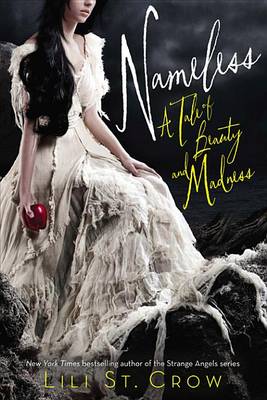Reviewed by Briana @ Pages Unbound on
Lili St. Crow laughs in the face of any complications. First, she takes the story of “Snow White” and chooses to be inspired by it, rather than simply modernizing it or fleshing it out. Thus, the family that takes Cami in is not a group of dwarves, silly or serious, or even a fraternity or whatever crazy sort of half-knit group one might suspect to see in a retelling. Rather, Cami is adopted by the Family—a literal family of beings that are part mafia, part vampiric, and part truly decent people. Things get serious, and creative, fast in Nameless.
As one might expect from all the hints about Family, there is some great original world-building happening in Nameless. In the beginning things are a bit hazy, with a plethora of unexplained references to jacks, minotaurs, Family, the Twist, mere-humans, et cetera. Eventually something of a solid picture begins to form. And eventually one realizes Nameless is set in an alternative future of our world, which came from an alternative past. It sounds as if things were the same until sometime around the Industrial Revolution, when something happened that leaked a bit of magic into the world. Then things went crazy. It is all laid out for readers interested in connecting our history with the history of the characters.
The one aspect that might be characterized as a weakness is Cami herself. She is on the whole a fantastic character, well-written and quite admirable in many respects. She gets into trouble she could easily have avoided, but unlike a number of YA protagonists, this is not simply because she is foolish or thinks she knows better than all her friends and ignores her advice. Cami chooses with open eyes to walk into danger because she truly thinks it will help. That conclusion may have come from some poor reasoning, but it still sets Cami apart as a strong young woman.
Before this climactic scene, however, Cami likes to dwell in self-doubt. She is not really Family. She does not really belong. No one really loves her. I grant this thought-process could have been much worse; there is certainly a line of “annoying self-hating character who blindly believes everyone hates her in spite of constant indisputable evidence” that St. Crow does not cross—but only barely. Cami also comes across as a little too dependent and even young at times, but, again, St. Crow stopped just short of making this a truly annoying issue. On the whole, Cami is awesome.
As is the book. The world has magic, but this is not high fantasy. Perhaps in some ways it is like magical realism. Magic is permeating our world, but it is slightly subtle and somewhat normal. People are magic, but the plot is not. There is certainly no cheesy enchanted food here; things are much more real. The effect is a slightly creepy, deliciously mystery atmosphere that fits St. Crow’s story perfectly. And I want more!
(Interestingly, Cami’s best friends have elements of Cinderella and Little Red Riding Hood about them that are fun to catch. Will the next books be about them?)
Reading updates
- Started reading
- 9 October, 2012: Finished reading
- 9 October, 2012: Reviewed
